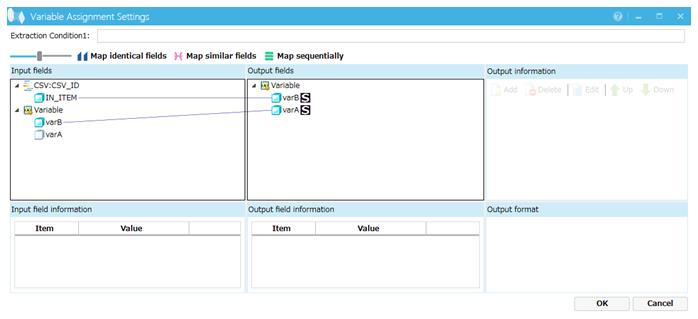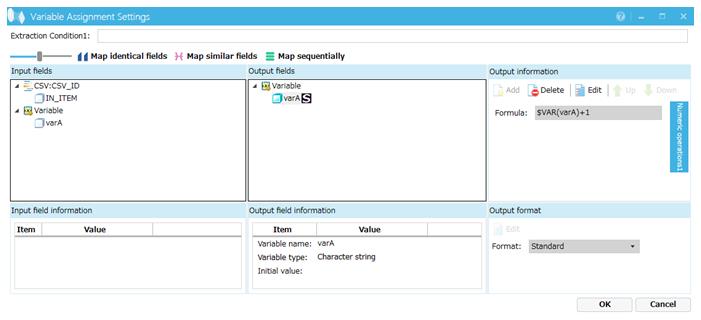Mapping variables
You can set three types of mapping to a variable as indicated below.
-
Mapping from an input field to a variable
-
Mapping from a variable to another variable
-
Mapping from a variable to an output field
A maximum of 1000 variables can be registered.
Just as in the output field of the output file, the contents listed in the table below can also be stored in a variable.
|
Content |
Remarks |
|---|---|
|
Concatenated character strings |
You can also use a start position, output size, and function. |
|
Fixed character string |
You can specify a hexadecimal value. (contains control characters) |
|
Dynamic character string |
You cannot specify a hexadecimal value. |
|
Date |
- |
|
Time |
- |
|
Numeric operation |
- |
|
Date operation |
- |
|
Common component |
- |
|
User exit program |
You can use only the character type. |
The following subsections explain some important points when setting variables in the Data Processing Settings screen.
(1) Mapping from an input field to a variable
This mapping stores the value of an input record in a variable. You set up this mapping in the Variable Assignment Settings screen. Dropping a variable icon to the extraction condition displays a variable assignment icon, and then double-clicking the variable assignment icon displays the Variable Assignment Settings screen.
(2) Mapping from a variable to another variable
This mapping stores a value stored in a variable into another variable. You can set this mapping in the Variable Assignment Settings screen. Dropping a variable icon to the extraction condition displays a variable assignment icon, and then double-clicking the variable assignment icon displays the Variable Assignment Settings screen.
- Correspondence rule between the mapping and the processing order
-
When mapping from variables to another variable, you need to consider the order in which values are stored in the variables. In data processing, the data is processed in the order the variable icons are arranged in the mapping tree of the Variable Assignment Settings screen. Therefore, values are stored in variables in the order starting from the variable icon placed at the top in the mapping tree.
-
The following is an example of mapping from variables to variables (example of settings in the Variable Assignment Settings screen in the Data Processing Settings screen).
-

Screen 3.14 Example of mapping from a variable to another variable
-
In this example, when the data processing is executed, the values are stored in the following order:
-
1) The value of the input field IN_ITEM is stored in Variable B.
-
2) The value of Variable B (the value stored in 1) is stored in Variable A.
-
- Processing that uses the same variable
-
You can also use only a single variable.
-
The following is an example of mapping that uses the same variable (setting example of the Variable Assignment Settings screen in the Data Processing Settings screen).
-

Screen 3.15 Example of mapping that uses a same variable
-
In this example, Variable A is used as the counter. When the data processing is executed, each time the input record is loaded, 1 is added to the value of Variable A.
(3) Mapping from a variable to an output field
The value stored in a variable is output to an output field of the output file. To set this mapping, establish a connection from the extraction condition to the output file.